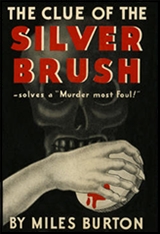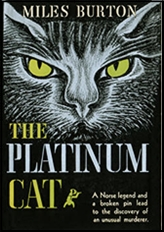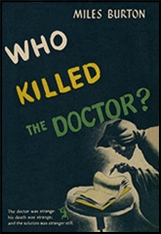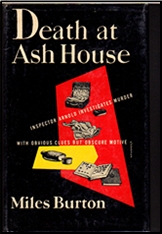Mon 1 Mar 2021
by Francis M. Nevins
More than half a century ago a young man happened to notice a curious fact about two English detective novelists of the Golden Age and ran with it. The authors were John Rhode and Miles Burton and the young man was me. The curious fact was that, whenever anyone in a book by either writer was asked a question, we were always told that he or she “replied.†Both authors were prolific, and that simple word must have appeared in their complete works thousands of times. It was clear, to me at any rate, that the same man was behind both bylines.
Today the identity of Rhode and Burton, whose real name was Cecil J. C. Street (1884-1965), is acknowledged in a host of reference books and on countless websites. Over the generations since I caught on to the fact, I’ve read a fair amount of Rhode, who was quite well known in the U.S., but precious little of Burton, who wasn’t. Late last year I decided it was time to revisit Burton and soon concluded that his personal golden age, like Rhode’s, was the 1930s. Shall we check him out?
THE MILK-CHURN MURDER (1935; U.S. title THE CLUE OF THE SILVER BRUSH, 1936) was the twelfth novel under the Burton byline, the fourth to appear over here, and the first to be published by Doubleday Crime Club, which remained his American publisher as long as he had one. Just as all but a handful of the Rhode books feature that scientific curmudgeon Dr. Priestley, the protagonists of the vast majority of Burtons are wealthy amateur of crime Desmond Merrion and his Scotland Yard buddy Inspector Arnold.

Merrion’s forte, unlike Priestley’s, is the spinning of elaborate theories of the crime he’s investigating based on a tiny number of evidentiary hints, and he spins like a manic spider in MILK-CHURN. We open with a vivid portrayal of dairy farming in the rural west of England and soon segue into the discovery of a headless and dismembered body inside a huge milk can. (The original title leads me to suspect that in the English edition the can was called a churn, a word that never appears in the American text, which was apparently altered in other ways too, for example the conversion of distances from meters to miles.)
The can also contains several other objects — a worn leather wallet stamped with the initials ALS, the frame of a pair of lens-less spectacles bearing the same initials, a hotel-room key, a railway timetable — and, in one of his imaginative leaps, Merrion concludes that some of the clues were meant to mislead the police and others to help them find the murderer. In due course there’s a second gruesome death, the victim being a woman who was stripped naked and thrust face first into the fireplace in Merrion’s flat, and then a third, the apparent suicide-by-hanging of the murderer.
In the final chapters comes something we almost never find in Rhode or Burton, an all-out action sequence. As Merrion and Arnold chase their quarry across a pitch-dark railway shunting yard filled with moving freight train cars, we might almost believe we’ve stumbled into a cop movie of fifty or sixty years later, perhaps starring Clint Eastwood.
THE PLATINUM CAT (1938) takes place at a time when the threat of a second World War hung heavily over the British Isles. A fire breaks out at 3:00 A.M., destroying an abandoned farm cottage in the Weald of Kent, and beneath the debris is discovered a man’s body, burned beyond recognition. The initials on a pair of cuff links strongly suggest that the dead man was an official of the Ministry of Defence, one of the three men with access to the secret plans to be activated in case of an air raid on London.

But what was he doing in the Kentish countryside in the middle of the night, and why was he carrying the titular cat figure which was found on his body? Was he about to sell those secret plans to a foreign agent, or was he murdered by a jealous rival for the woman in his life? And what accounts for the allusions to Norse mythology with which the clues are studded?
As in THE MILK-CHURN MURDER there’s plenty of speculative theorizing between Merrion and Arnold, with Merrion again displaying his knack for coming up with wildly imaginative theories based on a few shreds of evidence. This time however he fails to discover the truth, although a sort of justice is done and England’s secrets are preserved. One of the book’s unusual aspects is the identity of the adversary country.
In a novel set in 1937, when war with Hitler’s Third Reich was widely believed to be inevitable — as witness, for example, William L. Shirer’s BERLIN DIARY (1941) and the final chapters of the first volume of Norman Sherry’s GRAHAM GREENE: A BIOGRAPHY (1989) — Hitler is never mentioned and the perpetrator of the espionage against England is, as you might have guessed, the Soviet Union. I can’t resist indulging in a Merrionesque speculation: might Rhode/Burton’s books have been published in Germany but not in the U.S.S.R.?
The next Burton on my shelves dates from the thick of the war and is more interesting as a picture of an English small town in wartime than as a detective novel. In MURDER, M. D. (1943; U.S. title WHO KILLED THE DOCTOR?) nothing much happens for quite a while beyond the introduction of various village characters. The local doctor has joined the military and his replacement or locum (which comes from the Latin locum tenens) is a native Austrian who is more competent professionally than his predecessor but has a talent for antagonizing everyone he meets and is widely suspected of being a spy.

In Chapter 3 this intruder into village life is found dead at the gravel-covered bottom of a small quarry with the back of his head bashed in. Everyone treats the death as an accidental fall while the doctor was out birdwatching; everyone, that is, but the local squire, Sir Mark Corringham, who asks visiting Captain Merrion to look into the matter. A few subtle clues convince Merrion that the doctor was murdered but he doesn’t share his conclusions with the authorities and nothing else happens until the arrival of the locum’s replacement, who turns out to be an attractive woman.
This lady takes over the practice and charms the community but is herself murdered by head-bashing after a few months, and Scotland Yard is summoned in the person of Merrion’s old compadre Inspector Arnold. Eventually Merrion has an inspiration and sets a trap.
The detection, when it finally comes, is reasonably interesting — although a map of the area and a timetable of everyone’s movements would have been helpful — but many modern readers might be more fascinated by the details of wartime existence: the blackouts, the rationing points, the hearing before what we would call a municipal court where Sir Mark in his capacity as justice of the peace fines a grocer five guineas and costs for “selling a vegetable-marrow at a penny above the controlled price,†the need for locals to go out into the woods and shoot pheasants, quail and rabbits if they want dinner.
During the war years the mystery critic for the San Francisco Chronicle was Anthony Boucher, who usually had a kind word for the John Rhode novels that crossed his desk but reserved some of his snarkiest remarks for Burton, unaware that the two authors were one. On THIS UNDESIRABLE RESIDENCE (1942; U.S. title DEATH AT ASH HOUSE) he said: “Inspector Arnold plods through the problem of the bashed secretary and at last catches up with the reader. Relentlessly painstaking — -and giving.†MURDER, M. D./WHO KILLED THE DOCTOR? he dismissed as infuriatingly snobbish and “[a]mmunition for Anglophobes.â€

In his review of FOUR-PLY YARN (1944; U.S. title THE SHADOW ON THE CLIFF) he described Merrion’s specialty as “clearing the aristocracy and proving that crime is a property of commoners.†Of NOT A LEG TO STAND ON (1945) he conceded that the “[s]omewhat ingenious puzzle lifts this above the dismal run of Burton novels.†Least of all did he like EARLY MORNING MURDER (1945; U.S. title ACCIDENTS DO HAPPEN, 1946), which he called “dull, endless and snobbish†and featuring “the most incompetent detection…of the past decade….â€
The last four Burtons published in this country came out in the interim between Boucher’s departure from the Chronicle and the beginning of his legendary tenure as mystery critic of the New York Times. His comments leave me with little interest in exploring any of these books. If you’re determined to read Burton, my advice is to stick to his novels of the Thirties. If you can find any.
March 1st, 2021 at 7:58 am
“the conversion of distances from meters to miles”. It would be kilometres rather than mere metres, and miles would have been in the original British publication anyway. Distances in the UK are till measured in miles.
In the UK a milk-churn is a large container containing a lot of milk. They’re used for transporting milk or keeping it to churn into butter. A milk-can isn’t a common word, but I would assume it carried a small amount of milk – one or two pints – to ransport it for use by a few people more safely than in a bottle.
March 1st, 2021 at 10:59 am
I certainly agree with Boucher about “Early Morning Murder” – Merrion does nothing in it except explain why the deaths probably weren’t murder, and if the killer hadn’t confessed no-one would have been any the wiser.
“Death in the Tunnel”, recently reprinted, is worth your time, though, as is “The Three Corpse Trick”.
March 1st, 2021 at 12:50 pm
I always preferred the Burton books over the ones Street did as Rhodes, which I always found stuffy, for lack of a better word. It was very frustrating at the time I was always on the lookout for ones I didn’t have (1970s) to discover that many of the Burton’s were never even published in this country.
A few have been reprinted recently, but not nearly enough.
March 1st, 2021 at 6:58 pm
Steve,
Agreed about Merrion and Burton over Priestly and Rhode, and I would name THE SECRET OF HIGH ELDERSHAM as Street’s best book combining a solid well detected mystery, interesting village background, a supernatural threat well handled, and some well done action including Merrion literally at sea and in danger.
There are several Burton’s available in e-book form. I can’t say I have much appreciation for either of Street’s incarnations after the early Fifties, but some of the early Priestly’s and many Merrion’s are well worth a read. As Rhode he even managed a decent nor Priestly thriller about that favorite of the Twenties, Cocaine trafficing.